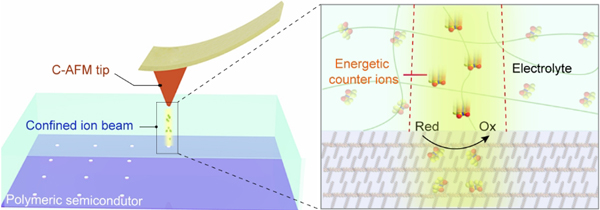Electrochemical Ion Implantation Brings Polymer Doping to Nanoscale
Soft polymers constitute the building blocks of the flexible and stretchable electronics, but typically requires controllable doping to tailor their electrical properties on demand. Ideally, the doping process should be precise down to nanoscale to enable the creation of nano-optoelectronic devices and to ease their on-chip integration.
Recently, Prof. DI Chongan from the Institute of the Chemistry of Chinese Academy of Sciences (ICCAS) and Prof. ZHANG Fengjiao from the University of Chinese Academy of Sciences, developed an electrochemical ion-implantation technique that allows nanoscale doping of the soft polymers. The related research titled Nanoscale Doping of Polymeric Semiconductors with Confined Electrochemical Ion Implantation was now published in Nature Nanotechnology.
The researchers found that the electrochemical redox doping of the polymers relies on electromigration of ions under electric field, resembling to the conventional single ion implantation (SII) used for inorganic materials but operating with an ultralow energy.
Inspired from SII doping, the researchers employed a nano-conductive tip and a glassy electrolyte to confine counterions migration. The glassy electrolyte comprises room-temperature ionic liquids and high glass-transition temperature insulating polymers, which is used to reshape the fringing electric field.
By carefully modulating the electrolyte glass transition, a record resolution of 56 nm with a lowest lateral-extended doping length (LDL) down to 9.3 nm was obtained. Moreover, the researchers uncovered a universal exponential relationship between resolution and the difference in electrolyte glass transition temperature and the operating temperature (Tg—T). They also established a phase diagram to depict the doping resolution across a wide range of polymeric semiconductors.
To verify the mechanism, the researchers combined ion dynamic analysis and finite element simulation, and found that increasing Tg—T could substantially decoupled ion transport from segmental relaxation of the insulator matrix, thereby contributing to highly localized electric fields and associated anisotropic ion electromigration.
Beyond these achievements, the implication in polymer electronic field was also demonstrated, including a 200% performance-enhanced organic transistor and a lateral p-n diode with seamless junction widths of sub-100 nm. More importantly, by combining the tip array, the scalability was further demonstrated with doping arrays of 2×2 cm2 achieved in 10 seconds.
This study represents a conceptual and technological advancement, and could serve as a powerful tool for exploring nanoscale polymeric optoelectronics.

Electrochemical ion implantation concept for nanoscale doping of polymers (Image by XIANG Lanyi)
Contact:
Prof. DI Chongan, Prof. ZHANG Fengjiao,
Institute of Chemistry, Chinese Academy of Sciences
Email: dicha@iccas.ac.cn, fjiaozhang@ucas.ac.cn





